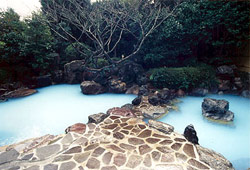**Announcement: Japanese Guest Houses has a new "sister site" - Japan Roads - for people
who are interested in doing a tour of Japan. For more information, click here.
Taking a bath, rather than taking a shower,
is very
popular in Japan and public bathing is an important part of the Japanese
culture. In Japan, there are two purposes to taking a
bath: cleaning your body and relaxing your body.

The first step is cleaning
your body and this is done outside of the bath tub. Bathers sit on stools and wash their bodies
using an attached shower head and hose.
Once you have finished rinsing off all soap and shampoo, step into the bath tub for a nice, relaxing soak. The bath tub can be very hot at times so you may not want to stay in for very long. You can go in and out of the bath as many times as you like. Although many people are used to taking showers in the morning to clean their bodies, it is a wonderful feeling to soak in a nice hot bath and relax your muscles at the end of the day.
 Changing Room Changing Room
Take off all your clothes and put them away together with your drying towel.
Washing Your Body
When you leave the changing room and go into the bathing area, go straight toward the area with the row of stools, mirrors, shower heads, and water taps. Sit on one of the stools and rinse your body with water from the taps and the shower heads. You can also use the soap, shampoo, and conditioner that may be provided. There are washbowls you can use to douse your body with water.
Washing Towel
Bathers in public baths and hot spring baths are naked; swimsuits are not allowed. Instead, bathers bring small towels that are used to cover their private areas when outside of the baths. When inside the bath, you should keep these towels out of the water (you can put them on the edge of the bath or on your head).

In the Bath
Once your body is clean and all soap and shampoo is rinsed off, you are ready to enter the bath. Before stepping into the water, it is a good idea to test the temperature with your foot so you have some idea of the water temperature. Some hot spring water can be very hot! Enter the bath slowly and try to move as little as possible (the more you move, the more the hot spring water is stirred and the hotter the bath gets).
Enjoying the Bath
As with any Japanese bath, you are free to enter and exit the bath as many times as you like as long as you wash your body and hair first. Sometimes there are outdoor baths and you are free to use these as well.
If you are bathing in hot spring water, at the end of the bath it is best not to rinse your body with tap water - the minerals in hot spring water are often beneficial, and washing them off will stop them from taking full effect.
Please avoid horseplay and making loud noises in public or hot spring baths, as the atmosphere is suppose to be one for relaxation and quiet conversation.
When in Doubt...
If you get confused about what to do, just watch and try to mimic what everyone else is doing. It is a truly unique, Japanese experience and sometimes the best way to learn is to imitate. Other Useful Ryokan Information
If you have never stayed at a ryokan, then Planning
Your Stay at a Japanese Ryokan will help you better plan
your stay.
Our Ryokan Styles page
will tell you about the various types of ryokans available
If it is your first time staying at a ryokan, you may want to
read our page on Ryokan Customs
Here is some more detailed information about Staying
at a Ryokan including ryokan cuisine
For more information about dining on Japanese "kaiseki," please
see Japanese "Kaiseki" (traditional,
multi-course dinner)
In A Ryokan Experience,
a guest describes his stay at a ryokan on Miyajima Island
Read Interviews with
Three
Kyoto Ryokan Owners and their experiences hosting foreign
guests
A step-by-step explanation of how
to put on a Japanese "yukata" (robe)
Here is how to use a Japanese-style
toilet
How big is a tatami mat room? Go to this Tatami
Mat Conversion Table and find out.
Read David Paget's article "Japanese
Buddhist Temple Overnight" and a guest's article " A
Night on Mount Koya" about
their experiences staying overnight at Buddhist Temples on Mount
Koya in Wakayama Prefecture.
Read guest's Comments about
their ryokan stays
|
